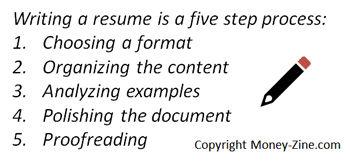Resumes are of critical importance to anyone looking for a job. Composing a resume that gets results doesn't happen by chance. It may be part art and part science, but following a prescribed format will increase the writer's prospects of being invited to a job interview. When writing a resume, it needs to stand out from the rest of the crowd. The competition in today's job market is fierce, so the document needs to make a lasting impression, and move the reader to take action. Selecting a format that highlights strengths and does not bring attention to potential weaknesses is imperative.
Writing a Resume
| Additional Resources |
| Resumes for Dummies Writing an Entry Level Resume |
It's important to go through a systematic check to make the process of writing a resume as efficient as possible. A mistake many individuals make is to sit down and start typing without a plan; hoping the finished product is a good one. This is not a very efficient way to go about writing a resume. The correct process is straightforward, and only involves five steps:
Choosing a Format
Organizing Content
Analyze Examples
Polish the Document
Proofreading
Choosing a Format
There are only three resume formats in use today: chronological, functional and combination; each one has its strengths and weaknesses. Ultimately, the choice comes down to only two factors: the objective of the job search, and the writer's depth of work experience. For example, the objective might be to move into a position of greater authority, or the writer might be looking to switch careers. New workers will tend to have fewer options than more experienced employees.

Functional Resumes
The functional resume style is a good format for students that are right out of college or anyone that has very little work experience. This format emphasizes the writer's skills, knowledge, and accomplishments. Unfortunately, this style can make some employers uncomfortable, since there is no formal account of prior work history.
Chronological Resumes
Perhaps the most traditional of the three formats, the chronological resume style places work experience early in the document in reverse chronological order. This makes potential employers or recruiters feel more at ease about the job applicant's work history. Anyone with employment gaps, or looking to make a career change, has better choices.
Combination Resume
This is arguably the most marketable of the three formats. The combination resume style leads with a functional arrangement, and finishes up with a chronological account of prior work experience. This format gives the writer the best of the earlier mentioned styles, and is well-suited to individuals that have a great deal of experience.
Resume Structure
While each of the three formats mentioned above contain links to more detailed information, the following list contains the essential elements of a combination resume, which borrows from the other two styles:
Name / Contact Information: a banner at the top of the page that includes essential contact information including name, street address, telephone number, and email address.
Education: many job postings list a certain level of "required" or "desired" educational background. If holding a certain degree is that important to the hiring manager, then it should appear up front in the resume.
Honors / Certifications / Licenses: just below the education section are listed any honors received and current certifications or licenses held.
Career Skills / Knowledge: a bulleted list of skills and knowledge gained in the working world. It's critical to make sure this section highlights the same attributes the job opening is seeking. For example, someone looking for a job as a financial analyst would highlight his or her ability to create and maintain complex spreadsheets.
Career Achievements: a second bulleted list of the applicant's most significant career accomplishments. Up to this point, the resume has focused on the most marketable knowledge, as well as accomplishments, which gives the reader a lot of information in a very succinct format.
Work Experience: this last section provides a summary of the applicant's work history in reverse chronological order. Anyone that's ever written a resume is familiar with this layout.
Organizing Content
The second step in writing a resume involves organizing content. This is a step that people often skip and regret later on. One approach to gathering this information is to assess strengths and weaknesses. Individuals that have been working for a while can pull out the feedback received in the past. This can be a Myers Briggs personality test, a survey completed by peers, or even a recent performance appraisal. Anyone right out of school can take a look at their courses completed. Reflect on compliments received from peers, and make a list of strengths and weaknesses. Write down the work done in the past that was fulfilling. Look for patterns in the information, and don't rush this exercise.
Analyze Examples
The third step involves reading several resume examples to help generate fresh ideas. Preferably, these examples will be in the same format chosen in the first step of this guide. Analyzing resume samples can help spark new ideas, and act as reminders of past accomplishments. At least one example of each style appears in the following article: Resume Writing Samples.
Polishing the Document
The process of making an excellent resume doesn't stop after all of the information elements have been written and organized. The next step in the process involves refining the information as well as the words on the document. This is sometimes referred to as polishing a resume. The process goes through several steps, as outlined by a simple three "B" technique:
Brainstorming: it's important to make sure every single element is thoroughly addressed. This means spending time looking through old job descriptions, performance appraisals, and any other archived file that might trigger a memory of a significant career event.
Buzz Words: the document needs to do more for the reader than provide a factual account of someone's career. It also needs to be a high-performance marketing tool. It must contain the right power words, which will supplement the keywords appearing on the resume.
Bragging: a resume is never the place to be modest or humble. It's also not the place to commit resume fraud. It is important to find the middle ground.
Proofreading
The last step in the making of a great resume involves proofreading the document. When writing a resume, it's easy to overlook a mistake. That's why newspapers and magazines have line editors on staff. A great proofreader needs to look for proper word usage, correct grammar, as well as punctuation. If possible, someone besides the writer should proofread the document. If that's not possible, the writer should review the resume over time. Proofreading "tricks" include reading the document from the end to beginning, and / or printing the document and using a ruler to expose one line at a time. When choosing a proofreader for a resume, it's best to pick a trusted and knowledgeable friend, significant other, or relative. Unless it's acceptable for an employer to know the writer is looking for a job, the proofreader should never be a coworker, even a trusted one.
Printing a Final Copy
Finally, while it might seem frugal to print on both sides of the paper, don't do it. It's also acceptable to use more than one page for a resume. Use fonts in the 10 to 14 point range, using the larger ones to highlight important sections of the resume; pick one style and stick to it. The recommended fonts include Arial, Calibri and Times New Roman. Bolding can be used sparingly, but try to stay away from italics or other decorative styles.
Resume Writing Help
Oftentimes a lack of inspiration will prevent writers from being able to express their thoughts on paper. This website has a number of resources that can help generate new ideas, and hopefully inspire individuals to re-write their resumes:
Resume Outline: provides additional guidance on the various sections of a resume, as well as explanations of the information contained in each section.
Resume Power Words: a listing of over 300 words that can have a positive impact on the reader.
Resume Writing Samples: a list of over two dozen downloadable examples.
Discovering Resume Keywords: explains how to find the key phrases and words appearing in job openings as well as their importance.
About the Author - How to Write a Resume


